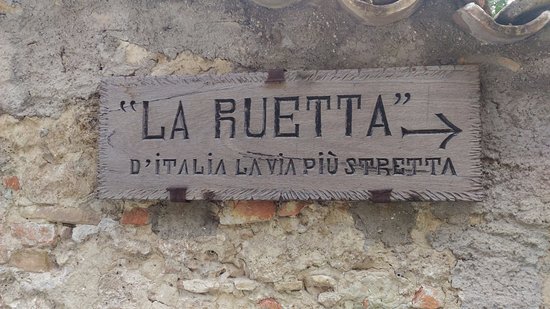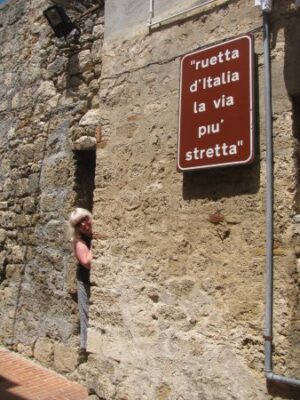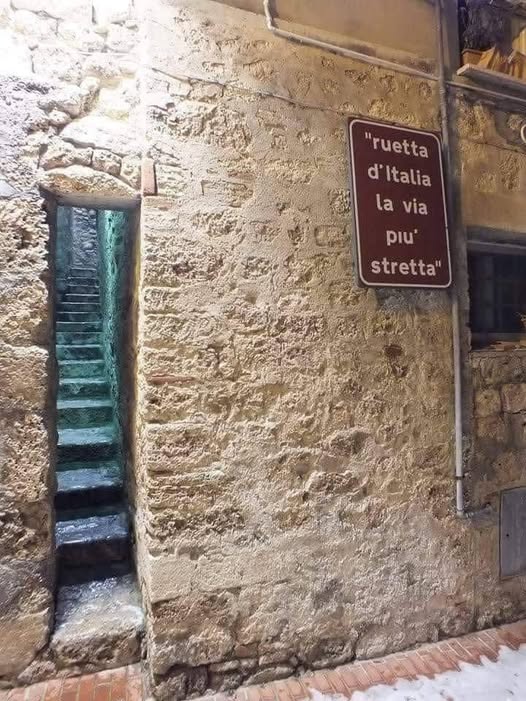Nestled near the entrance of the medieval fortress in Civitella del Tronto, Abruzzo, lies a fascinating historical gem: La Ruetta di Civitella, Italy’s narrowest street. At just 40 cm wide, this unique alleyway offers a glimpse into the ingenuity and strategic brilliance of medieval urban planning. Follow archeology.dulichvn.net to discover many hidden mysteries that have yet to be discovered.

1. A Historical Marvel in Civitella del Tronto
1.1 The Fortress of Civitella del Tronto: A Stronghold of History
The Fortress of Civitella del Tronto is one of Italy’s most impressive historical landmarks, standing as a monument to the country’s rich military and architectural heritage. Perched high above the town, this massive structure was originally built in the 16th century and played a key role in defending the region against invaders.
Its strategic location on a hill allowed the defenders to have a commanding view of the surrounding area, providing a tactical advantage in times of conflict. The fortress’ intricate layout, which includes thick walls, complex pathways, and defensive towers, was designed specifically to thwart enemy forces, making it an impenetrable stronghold. As a symbol of military might and ingenuity, the fortress remains a key part of Civitella del Tronto’s identity and an essential piece of Italy’s medieval history.
1.2 La Ruetta: A Clever Defensive Strategy
La Ruetta, the narrowest street in Italy, is much more than an architectural curiosity; it was a crucial element of the town’s defense strategy. With its mere 40 cm width, this passageway was intentionally designed to be impassable for enemy troops, ensuring that any invader would be unable to traverse it with ease. The strategic design of such narrow streets served a dual purpose: it not only thwarted attackers but also allowed the town’s defenders to use the alley as a hidden route for ambushing invaders or retreating if necessary.
La Ruetta’s confined space offered both defensive protection and an element of surprise, ensuring that the residents of Civitella del Tronto could hold their ground in times of conflict. Its historical significance lies in how this narrow street played a vital role in protecting the community and defending the fortress.
1.3 A Glimpse into Medieval Life and Survival
La Ruetta also offers us a fascinating glimpse into the daily lives and survival strategies of medieval communities. Beyond its military function, the narrow street reflects the ingenuity of those who lived in fortified towns. The design of the streets and alleys, like La Ruetta, was essential for the survival of the townspeople, as they had to adapt to both external threats and the challenges of daily life.
The narrowness of the street not only made it a defensive asset but also influenced how people interacted with their surroundings—forcing them to navigate tight spaces, limit accessibility, and make the most of their urban environment. These clever, resourceful solutions reveal how medieval societies were constantly adapting to their circumstances, finding ways to protect their homes and families, and preserving their way of life amidst an often hostile world.

2. The Architecture of La Ruetta di Civitella
2.1 Dimensions of Uniqueness: The Narrowest Street in Italy
La Ruetta stands out for its extraordinary width—or rather, its lack thereof. Measuring only 40 cm across, it is undeniably one of the narrowest streets in the world. For modern visitors, walking through this tight passage feels almost impossible, yet it’s a remarkable representation of medieval design.
The street’s extreme narrowness wasn’t just an aesthetic choice; it was a practical decision meant to serve a very specific function. Its limited dimensions underscore the creativity and resourcefulness of medieval architects who prioritized defense and protection in every aspect of urban planning. This tiny alleyway, though impractical for larger crowds, remains an iconic feature of Civitella del Tronto, symbolizing the unique challenges and solutions of ancient builders.
2.2 Practical and Strategic Design: Defense Through Narrowness
The narrow design of La Ruetta wasn’t merely for show—it had a crucial strategic function in the defense of the town. In medieval fortified cities, such narrow alleys were common and specifically designed to outsmart invaders. The constricted space prevented enemy soldiers from advancing in large numbers, creating confusion and making it difficult for them to navigate.
The street’s tightness also provided locals with the advantage of quick escape routes and hidden pathways, allowing them to retreat swiftly or stage surprise ambushes against attackers. By constraining movement and limiting access, La Ruetta made it nearly impossible for invaders to launch a successful assault, demonstrating the thoughtful and strategic approach to city defense employed by medieval engineers.
2.3 Preservation of Medieval Urban Planning: A Link to the Past
La Ruetta stands as a well-preserved testament to the architectural brilliance of medieval urban planning. As one of the most distinctive features of Civitella del Tronto, the narrow street offers a rare opportunity for visitors to experience the ingenuity of ancient builders firsthand. The preservation of La Ruetta, along with the broader medieval layout of the town, provides valuable insight into the design and function of fortified cities.
This meticulous preservation allows modern audiences to connect with the past, experiencing the tactical advantages and urban strategies that shaped life in those turbulent times. Furthermore, it highlights the importance of safeguarding historical landmarks, ensuring that future generations can appreciate the unique architectural practices that have stood the test of time.

See more: Lady of Baza: A Timeless Artifact of Celtiberian Culture
3. Visiting La Ruetta Today
3.1 A Unique Tourist Attraction: A Walk Through History
La Ruetta stands as one of the most fascinating and unique attractions in Italy. Its exceptional narrowness—just 40 cm—makes it a memorable spot for history lovers and adventurous travelers. Walking through this diminutive passage is not just an unusual experience; it’s a rare opportunity to physically step into the past. Every inch of this tiny street tells a story, inviting visitors to imagine the strategic minds that designed it for defense. It’s a place where history comes alive, offering a unique glimpse into the architectural practices of medieval times, making it a must-see destination for anyone visiting Civitella del Tronto.
3.2 Exploring Civitella del Tronto: More Than Just La Ruetta
While La Ruetta is undoubtedly a highlight of Civitella del Tronto, the town itself offers a wealth of historical and scenic attractions. The town’s medieval charm can be seen in its cobblestone streets, which wind through picturesque alleys, and the towering fortress that dominates the landscape, offering panoramic views of the Abruzzo region. Visitors can explore the fortress’s fascinating history, from its role as a military stronghold to its importance in local heritage. Whether strolling through the ancient streets or enjoying the breathtaking scenery, Civitella del Tronto offers a rich and immersive experience for those seeking to connect with Italy’s past.
3.3 Capturing the Essence of History: Immersive Cultural Experience
Visiting La Ruetta is not just about admiring its narrowness; it’s about diving deep into the history of medieval Italy and reflecting on the ingenuity of its people. As you walk through this tight passageway, you’re stepping into a world where every architectural decision had a purpose, and where the streets themselves were designed with strategic foresight. This journey is an opportunity to gain a deeper understanding of the defense mechanisms of medieval towns and to appreciate the resilience and creativity of their builders. La Ruetta is a living history lesson, where the stories of ancient times continue to be told through the very stones beneath your feet.

Conclusion
La Ruetta di Civitella is more than just the narrowest street in Italy—it’s a symbol of medieval strategy, ingenuity, and resilience. Its historical significance, coupled with its architectural charm, makes it a fascinating destination for travelers seeking to explore the rich heritage of Civitella del Tronto and Abruzzo. Whether you’re a history buff or simply looking for a unique travel experience, La Ruetta promises to leave a lasting impression.


CÁC TIN KHÁC
Mary Walton: The Forgotten Inventor Who Helped Clean Up America’s Cities
Tomb of Queen Nefertari in the Valley of the Queens, Egypt
Discover the Hypostyle Hall of the Temple of Hathor at Dendera
Venus de Losange: Unveiling the Mystery of a 20,000-Year-Old Paleolithic Icon